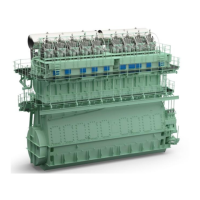Operation
0260−1/A1
Winterthur Gas & Diesel Ltd.
1/ 3
Manoeuvring
1. General
Correct maneuvering, with a subsequent increase in engine load up to service power
and a decrease in load from service power, is very important.
Engine loads in the higher power ranges that are changed too quickly can cause
increased wear and contamination, specially on piston rings and cylinder liners.
Slow load changes let the piston rings adapt to the new conditions and therefore
make sure of the best sealing.
There must always be sufficient power available in a short time for safe manoeuvring
in ports and waterways.
2. Maneuvering
Maneuvering is the operation between leaving port and release to sea speed and
from the approach to port until finished with engine. This also includes all changes
during usual service e.g. changes of direction.
The manoeuvring range is the speed range between FULL AHEAD and FULL
ASTERN. This range is usually divided into four manoeuvring steps with related given
speeds in each direction.
Note: Because of torsional vibration, it is possible that the engine has more
than one barred speed range. Also, it is possible that the engine has a
barred speed range if the axial damper becomes defective. Data about the
barred speed range can be found near the telegraph on the bridge, and/or
near the local control panel.
Usually, the full maneuvering speed, for engines that have fixed pitch propellers, is
related to approximately 70% of the maximum rated engine speed. This is
approximately 35% of the maximum power. This means that when sailing straight
ahead, the ship will be at approximately 66% of its maximum speed.
A fully serviceable engine can be manoeuvred in the range given above with no time
or performance limits. Fuel and scavenge air necessary for engine operation are
controlled electronically.
With controllable pitch propellers the speed and torque can be freely selected. During
maneuvering, the limits are the same as for fixed pitch propellers. The time period to
change the propeller pitch position from zero pitch to full, must be a minimum of 20
seconds.
If the engine is increased quickly to full maneuvering speed (or the propeller blades
move to full pitch), the engine load is momentarily higher when the vessel has no
movement. When the vessel is at sea speed, the engine load is decreased.
You can do maneuvering operations from the bridge (if the remote control is installed),
from the engine control room or at the local control panel on the engine.
Make sure that you know the special precautions for maneuvering operations from
the local control panel.
Heavy fuel oil or diesel oil can be used during maneuvering, but heavy fuel oil is
recommended (see 0270−1, paragraph 1).
The fuel used must have sufficient treatment (see 0720−1 Fuel Treatment, Fuel Oil
System).
The data given in 0250−1, Operating Data Sheet is also applicable during
manoeuvring.
2014
Operation

